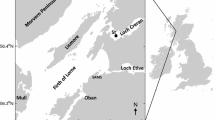Abstract
It is now possible to divide particulate primary production into algal and heterotrophic components without physical separation. This depends on two innovations, the introduction of isotope in the form of labelled dissolved product(s) of primary production and the employment of a data analysis specifically designed for tracer kinetic incorporation experiments. The 14C technique described by Steemann Nielsen (1952) is inapplicable in the analyses of certain classes of systems and kinetic tracer incorporation experiments must be employed instead. We show that measurement of PDOC production rate requires such kinetic tracer analyses. Measurements made in the laboratory on water taken from 2 m depth in South West Arm of the Port Hacking estuary showed that: (1) the steady-state rate of PDOC production was 0.10 to 0.13 mg C.m-3.h-1; (2) the rate of PDOC incorporation into microheterotroph particulate organic carbon was 0.10 to 0.12 mg C.m-3.h-1; (3) the rate at which PDOC was respired to CO2 was 0.001 to 0.003 mg C.m-3.h-1. (4) the PDOC makes up only about 0.1% of the total dissolved organic carbon. The size class of particles associated with PDOC production differed from the size class responsible for uptake of PDOC. More than 50% of the PDOC production was associated with particles having a nominal diameter range of 20 to 63 μm, while this fraction was responsible for <10% of the incorporation.
Similar content being viewed by others
Literature Cited
Azam, F. and O. Holm-Hansen: Use of tritiated substrates in the study of heterotrophy in seawater. Mar. Biol. 23, 191–196 (1973)
Bergner, P.E.: Tracer dynamics and the determination of pool-sizes and turnover factors in metabolic systems. J. theor. Biol. 6, 137–158 (1964)
—: Exchangeable mass: determination without assumption of isotopic equilibrium. Science, N.Y. 150, 1048–1050 (1965)
Berman, M. and R. Schoenfeld: Invariants in experimental data on linear kinetics and the formulation of models. J. appl. Phys. 27, 1361–1370 (1956)
—, M.F. Weiss and E. Shahn: Some formal approaches to the analysis of kinetic data in terms of linear compartmental systems. Biophys. J. 2, 289–315 (1962)
Berman, T. and O. Holm-Hansen: Release of photo-assimilated carbon as dissolved organic matter by marine phytoplankton. Mar. Biol. 28, 305–310 (1974)
Choi, C.I.: Primary production and release of dissolved organic carbon from phytoplankton in the western North Atlantic Ocean. Deep-Sea Res. 19, 731–735 (1972)
Crawford, C.C., J.E. Hobbie and K.L. Webb: The utilization of dissolved free amino acids by estuarine microorganisms. Ecology 55, 551–563 (1974)
Derenbach, J.B. and P.J. Le B. Williams: Autotrophic and bacterial production: fractionation of plankton populations by differential filtration of samples from the English Channel. Mar. Biol. 25, 263–269 (1974)
Draper, N.R. and H. Smith: Applied regression analysis, 407 pp. New York: J. Wiley 1966
Eppley, R.W. and J.H. Sharp: Photosynthetic measurements in the central North Pacific: the dark loss of carbon in 24-h incubations. Limnol. Oceanogr. 20, 981–987 (1975)
Fogg, G.E., C. Nalewajko and W.D. Watt: Extracellular products of phytoplankton photosynthesis. Proc. R. Soc. (Ser. B) 162, 517–534 (1965)
Hansen, R.B.: Heterotrophic utilization and mineralization of dissolved organic carbon in a salt-marsh estuarine ecosystem. In: Annual Meeting Abstracts of the American Society for Microbiology, p. 178. Washington, D.C.: American Society for Microbiology 1976
Hart, H.E.: Analysis of tracer experiments: II. Non-conservative non-steady-state systems. Bull. math. Biophys. 19, 61–72 (1957)
Hellebust, J.A.: Extracellular products. Bot. Monogr. 10, 838–863 (1974)
Jitts, H.R.: A twin six litre sampler. Limnol. Oceanogr. 9, p. 452 (1964)
Laws, E. and J. Caperon: Carbon and nitrogen metabolism by Monochrysis lutheri: measurement of growth-rate-dependent respiration rates. Mar. Biol. 36, 85–97 (1976)
Mann, J. and E. Gurpide: Generalised rates of transfer in open systems of pools in the steady state. J. clin. Endocr. Metab. 26, 1346–1354 (1966)
——: Interpretation of tracer data: some factors which reduce the number of terms in the specific activity functions in n-pool systems. Bull. math. Biophy. 31, 473–486 (1969)
Parsons, T.R. and D.H. Strickland: On the production of particulate organic carbon by heterotrophic processes in sea water. Deep-Sea Res. 8, 211–222 (1962)
Pomeroy, L.R.: The oceans foodweb, a changing paradigm. Bioscience 24, 499–504 (1974)
Rescigno, A. and G. Segre: On some topological properties of the systems of compartments. Bull. math. Biophys. 26, 31–38 (1964)
Smith, D.F.: Quantitative analysis of the functional relationships existing between ecosystem components. I. Analysis of the linear intercomponent mass transfers. Oecologia (Berl.) 16, 97–106 (1974a)
— Quantitative analysis of the functional relationships existing between ecosystem components. II. Analysis of the non-linear relationships. Oecologia (Berl.) 16, 107–117 (1974b)
—: Quantitative analysis of the functional relationships existing between ecosystem components. III. Analysis of ecosystem stability. Oecologia (Berl.). 21, 17–29 (1975)
— and W.J. Wiebe: Constant release of photosynthate from marine phytoplankton. Appl. envirl Microbiol. 32, 75–79 (1976)
Steemann Nielsen, E.: The use of radioactive carbon (14C) for measuring organic production in the sea. J. Cons. perm. int. Explor. Mer 18, 117–140 (1952)
Thomas, J.P.: Release of dissolved organic matter from natural populations of marine phytoplankton. Mar. Biol. 11, 311–323 (1971)
Watt, W.D.: Release of dissolved organic material from the cells of phytoplankton populations. Proc. R. Soc. (Ser. B.) 164, 521–551 (1966)
Wright, R.T. and J.R. Hobbie: Uptake of organic dilutes in lake water. Limnol. Oceanogr. 10, 220–228 (1965)
——: Use of glucose and acetate by bacteria and algae in aquatic ecosystems. Ecology 47, 447–454 (1966)
Author information
Authors and Affiliations
Additional information
Communicated by G.F. Humphrey, Sydney
Rights and permissions
About this article
Cite this article
Wiebe, W.J., Smith, D.F. Direct measurement of dissolved organic carbon release by phytoplankton and incorporation by microheterotrophs. Mar. Biol. 42, 213–223 (1977). https://doi.org/10.1007/BF00397745
Accepted:
Issue Date:
DOI: https://doi.org/10.1007/BF00397745




